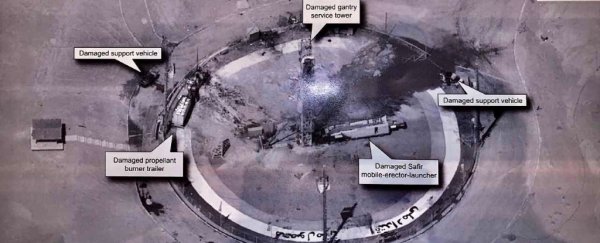The US President has tweeted an American spy satellite image. After some sleuthing, astronomers were able to figure out which satellite it came from: a (formerly) top-secret satellite called USA 224, an optical reconnaissance satellite.
Trump's tweet unwittingly revealed some of the capabilities of American satellite imagery. USA 224 has been kept top-secret for national security reasons, so the Intelligence Community is probably not very happy about this. Why reveal your intelligence-gathering capabilities to your adversaries, including Iran itself?
Iran and the USA have a fractious relationship going back decades. The USA accuses Iran of trying to develop nuclear weapons and of sponsoring terrorism. Iran accuses the USA of sponsoring terrorism by supplying Israel with billions of dollars worth of high-tech weaponry.
Things calmed down when Iran signed a deal under Obama limiting their nuclear technologies in exchange for relief from economic sanctions. When elected, Trump scrapped that deal. Since then, things between the USA and Iran have heated up again.
Iran has been developing launch capabilities for years now. They've been testing rockets at their Imam Khomeini Spaceport in norther Iran. At the end of August, a launch attempt failed on the pad. Unclassified satellite images showed a plume of smoke rising from the facility, and not much else.
But Trump loves to get his jabs in, so he tweeted this:
The United States of America was not involved in the catastrophic accident during final launch preparations for the Safir SLV Launch at Semnan Launch Site One in Iran. I wish Iran best wishes and good luck in determining what happened at Site One. pic.twitter.com/z0iDj2L0Y3
— Donald J. Trump (@realDonaldTrump) August 30, 2019
It appears that Trump was briefed with a print of this classified image, and that he took a picture with his phone and tweeted it. You can see the camera flash in the middle of the image. Immediately, people were concerned that he had revealed US surveillance capabilities.
Some people wondered what the big deal was. The image doesn't seem to reveal much, on the surface of it. But it's problematic, and here's why.
Astronomers are smart people. Much smarter and more resourceful than Trump can suspect. One Dutch astronomer named Marco Langbroek got to work on Trump's satellite image and revealed his findings in tweets of his own:
I measured the semi-major and semi-minor axes of the ellipse (the obliguely viewed circular platform). The viewing angle is then derived by minor=major*cos(angle) --> so find the matching angle. That yielded nominal 43.97 deg. That value matches 09:44:23 UT and azimuth 194.7.
— Dr Marco Langbroek (@Marco_Langbroek) August 31, 2019
So the position of the satellite at 09:44:23 was taken, and in STK I let the viewq from the satellite point towards the launch platform. That yielded this. It is a very good match so there is no doubt in my mind that it is an image taken by USA 224. pic.twitter.com/R4XGdnzPis
— Dr Marco Langbroek (@Marco_Langbroek) August 31, 2019
In an interview with NPR, Langbroek described USA 224 as a large telescope "not unlike the Hubble Space Telescope. But instead of looking up to the stars, it looks down to the Earth's surface and makes very detailed images."
USA 224 is a powerful, high-tech piece of equipment that cost billions of dollars to build. It has a 2.4 meter mirror, the same size as the Hubble's.
USA 224 is what's called a KH-11 satellite. It's the 15th satellite of that type. It's also called the "Evolved Enhanced CRYSTAL System" and code-named Key Hole.
The thing about USA 224 and satellites like it is that they're easy to track in the sky.
In a blog post at SatTrackCom, Langroek explained how the shadows in the image were combined with its location to find the time the image was taken. Then, that was compared with the known track of spy satellites to confirm that it was USA 224 that took the image.
Then Cees Bassa got to work. Bassa is a professional astronomer at ASTRON, the Netherlands Institute for Radio Astronomy. He was able to determine the resolution of the image, and the capabilities of USA 224 itself.
The detail in the image is surprising, even to satellite imagery experts.
In an interview with NPR, Melissa Hanham of the Open Nuclear Network in Vienna said, "… I did not believe [the image] could come from a satellite." Hanham also said that "I imagine adversaries are going to take a look at this image and reverse-engineer it to figure out how the sensor itself works and what kind of post-production techniques they're using."
Normally, there's a certain sobriety to intelligence gathering and surveillance. Nations like to keep their capabilities secret, sharing them with allies only when needed, and obfuscating and denying to their adversaries. Details of USA 224's capabilities, mission, and orbit are classified.
Now Trump has revealed some of the USA's cutting-edge spy capabilities, and a couple things stick out.
This image has a much higher definition than anything the US has admitted to in the past. Other nations probably guessed that the US has advanced satellite imaging, but now they no longer need to guess. In the high-stakes game of international intelligence and espionage, that matters.
Also, revealing security secrets is a crime. In 1984, an intelligence analyst at the Naval Intelligence Support Center sent three classified images from the KH-11 spy satellite to the Jane's Fighting Ships publication.
His name was Samuel Loring Morison, and he was convicted and sentenced to two years in prison, though he was later pardoned.
Trump won't face any charges though. As President, he has the right to reveal things like this. According to Trump himself, he has the "absolute right" to do so.
This article was originally published by Universe Today. Read the original article.
